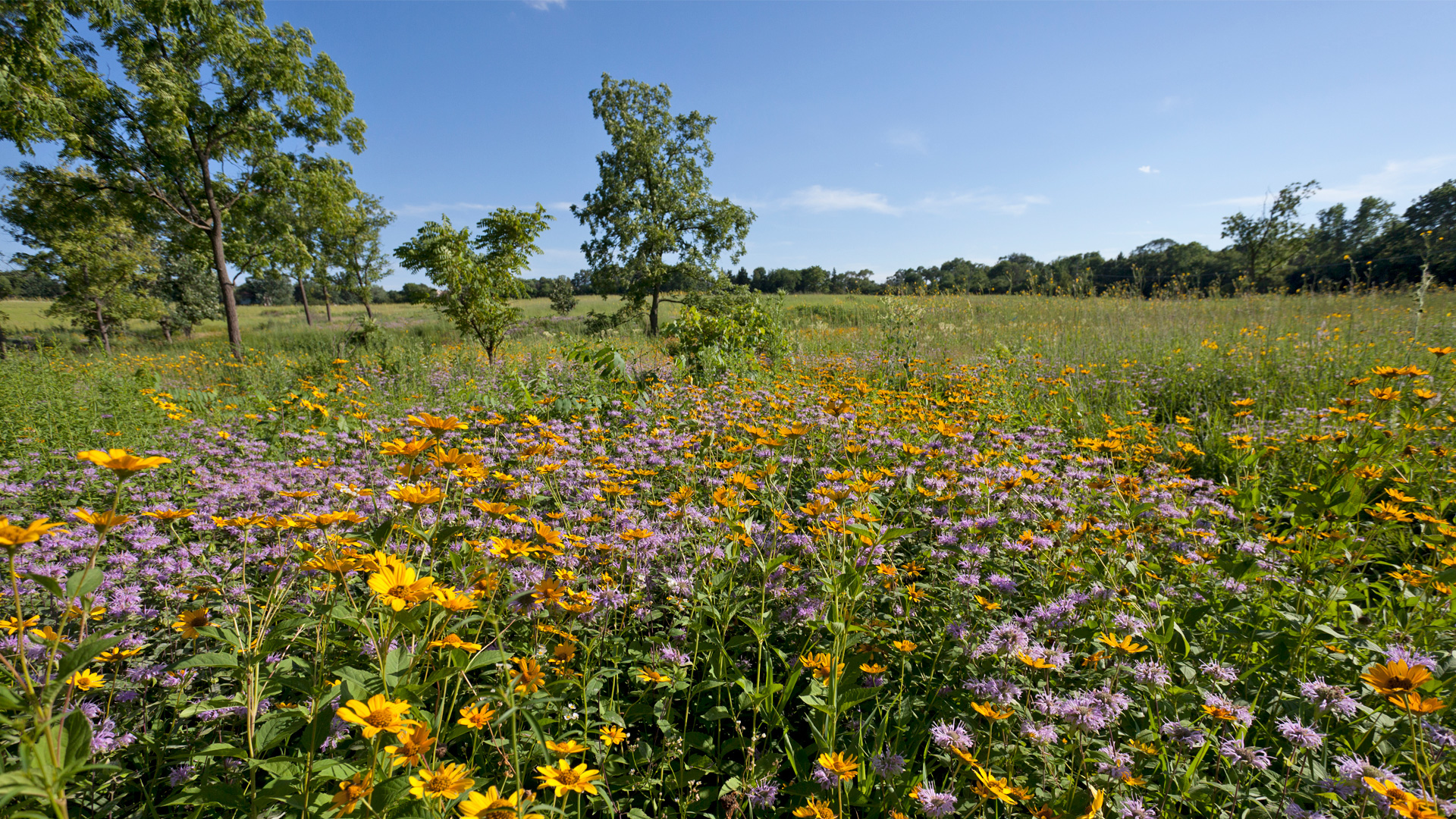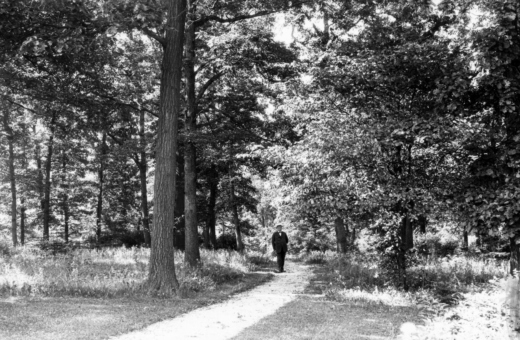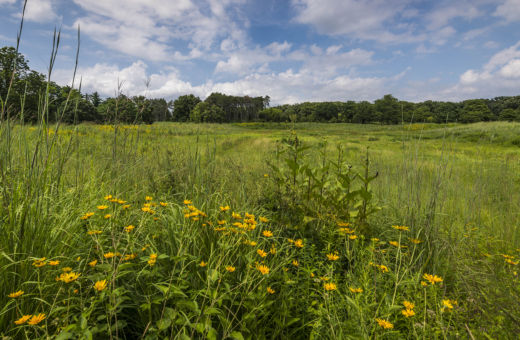September 6, 2022
On a warm September day, dozens of kinds of bumblebees bustle from flower to flower amid the swaying seed heads of tall golden grasses. Colorful butterflies flit: red admiral, painted lady, monarch, pearl crescent, great spangled fritillary. Birds call: twittering goldfinches, whistling meadowlarks, chirping bobolinks.
At the Schulenberg Prairie on the West Side of The Morton Arboretum, all this busy life depends on a rich community of more than 300 kinds of plants distributed over more than 100 acres, from wide-open, sunlit tallgrass prairie to shade-dappled savanna between oak trees. It evokes the kind of landscape that covered northern Illinois for thousands of years since the last glaciers melted. Yet just a few decades ago, the prairie was a farm field.
This year, the Arboretum is celebrating the 60th anniversary of one of the Midwest’s first and most successful prairie restoration efforts. The Schulenberg Prairie has influenced the development of ecological restoration and helped shape the Arboretum itself.
In the fall of 1962, Ray Schulenberg, the Arboretum’s curator of native plants, set out to collect seeds of native grasses and other plants from the few places where they survived 160 years after most of DuPage County had become farm fields: cemeteries, railroad rights of way, vacant lots. Beginning in 1963, they began planting those seeds in a single acre of ground on the Arboretum’s West Side.
Although the idea of restoring natural ecosystems on former agricultural land was new, and though techniques had to be worked out by trial and error, Schulenberg and his crew already knew one thing—plants were key. Bring back the plants, and the animals would follow.
They also knew that fire was critical. Prairie plants had evolved to cope with frequent wildfires. The Arboretum imitated the effect of wildfires with carefully controlled burning that renewed the prairie, favoring the native plants and knocking back non-native species such as Eurasian weeds and grasses.
After six decades of careful tending by staff and volunteers, the oldest acre of prairie is “close to a sustainable ecosystem,” according to Kurt Dreisilker, head of natural resources and collections at the Arboretum. “If you peek down among those tall plants, you see prairie plant seedlings in the ground, not weed seedlings. It’s renewing itself.”
Newer restored areas still need more help to resist being overwhelmed by invasive plants and other forces. But techniques and knowledge developed at the Schulenberg Prairie are used to improve ecosystems all over the Arboretum and beyond. It’s just one of the ways the influence of this prairie extends far beyond its borders.
Fire. Once the Arboretum’s staff had learned to use fire to renew the grassland prairie, they began to experiment with it in adjacent woodlands, Dreisilker said. The fire that cleared out choking invasive underbrush allowed native plants to return from seed, creating a savanna-type ecosystem among existing oak trees. Based on that experience, burns are now used to restore oak-dominated woodlands in the Arboretum’s East Woods, as well as other natural areas throughout the Arboretum and in restorations elsewhere.
Restoration. The Schulenberg Prairie—named after its founder on his retirement in 1987—was just the beginning of restoration efforts at the Arboretum. Now, more than 900 of the Arboretum’s 1,700 acres are managed as natural areas to improve habitat for native plants and animals and increase biodiversity.
Seed. Seeds of native plants collected from the Schulenberg Prairie have been used to restore many other areas. Expanses that once were lawns of Eurasian grasses now support native plant ecosystems rich with wildlife. When you walk a trail amid goldenrod, asters, bees, and butterflies, such as those near parking lots 9 and 14, you’re likely surrounded by plants that began as seeds collected from the Schulenberg Prairie.
Science. The Schulenberg Prairie has been studied since its inception both by the Arboretum’s own science staff and by researchers from other institutions. Many of the questions that the Arboretum’s scientists seek to answer today—such as how soils are affected by fire and how prairie plants’ genetic relationships affect restorations—can be traced to the prairie.
Influence. The Arboretum’s experience of restoring the prairie has guided many other restorations throughout the Midwest and the world. Ray Schulenberg worked with Arboretum taxonomist Floyd Swink on a widely influential book, Plants of the Chicago Region, first published in 1969. Becoming a bible for Midwest conservation work, it went through several editions and is still used today.
Volunteers. For decades, the prairie restoration has depended on volunteers who remove invasive plants, monitor wildlife, and collect seed. The prairie work corps—which still meets to work weekly all summer long—became the core of the Arboretum’s volunteer program, which now has more than 1,200 active volunteers involved in a wide variety of activities.
Training. As the volunteer program expanded from the prairie to a wider range of natural areas at the Arboretum, a training program was developed to help them understand not only techniques but the scientific concepts behind their work. Online teaching has allowed the Arboretum to extend that training to all people interested in ecological restoration through its N-ACT (Natural Areas Conservation Training) program.
Wildlife. From its deep oak woods to its wide-open prairie, the Arboretum’s natural areas offer a wide range of habitat for animals of all kinds. For example, Dreisilker said, more than 100 species of native bees have been found at the Arboretum, including rare species native to woodland savannas and sand barrens. That one-acre effort to create a “native planting” on a former farm field 100 years ago has led to a renaissance for nature throughout The Morton Arboretum.
Want to learn more about the prairie? Check out the September 16 class, Potawatomi Prairie Perspectives, or the October 12-16 Seasons of the Schulenberg Photography Exhibit.



